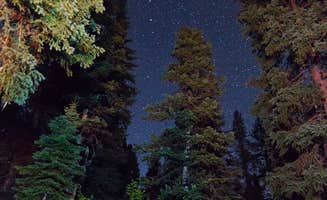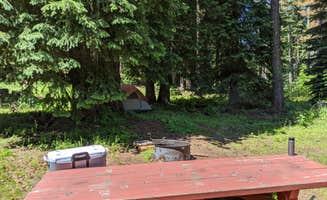Tent camping opportunities near Cayuse, Oregon extend throughout the Blue Mountains with multiple forest service access points. Elevations range from 2,500 feet in valley locations to over 5,000 feet at higher campsites, creating significant temperature variations between day and night. Forest service roads frequently require high-clearance vehicles, particularly after spring thaws when seasonal runoff creates washboard conditions and deep ruts.
What to do
Fishing opportunities: The area between Umapine Campground and surrounding creeks provides access to both Squaw and Umapine Creeks for anglers. "This campground is in a ponderosa forest right in between two creeks, Squaw and Umapine, so anglers were happy and it's easy to get a nice cool respite if the weather is oppressive," notes camper Allison W.
Trail exploration: Forest service roads throughout the Blue Mountains offer extensive hiking options with minimal crowds. According to Marasha L., at Wallowa-Whitman NF 21, there are "tons of great hiking around" once you navigate past the established campgrounds. The trails range from beginner-friendly paths to more challenging backcountry routes.
Wildlife observation: Early morning and evening hours provide the best wildlife viewing opportunities in the forest areas. Mel B. reports seeing "lots of elk and turkeys" during their stay, though cautions about occasional rattlesnake encounters in warmer months. Dawn and dusk present optimal viewing times when animals are most active.
What campers like
Privacy between sites: The dispersed nature of camping in this region offers considerable isolation for those seeking solitude. At Mottet Campground, Aaron B. appreciates that "there's lots of room between you and your neighboring campsite - if you even have neighbors, we were the only ones there." This contrasts with more crowded destinations like Jubilee Lake.
Abundant camping options: The extensive national forest land provides numerous opportunities for finding suitable tent sites. Blue Mtns North/Grande Ronde River Basin Area offers "lots of free camping" according to Brandon C., though accessibility varies significantly by season and vehicle capabilities.
Night sky viewing: The remote location and minimal development create excellent conditions for astronomy enthusiasts. The Mottet Campground area is described as a "great place for astrophotographers when conditions are right" due to minimal light pollution and open viewing areas in forest clearings.
What you should know
Access challenges: Many camping areas require careful navigation and appropriate vehicles. Nick B. warns about Bone Spring Campground: "Coming from Tiger Creek Road, it's about 20 miles down a dirt two-track. I wouldn't attempt this route without a 4x4 with decent ground clearance." Alternative access routes may be available from maintained roads.
Highway noise considerations: Proximity to Interstate 84 affects some camping experiences. Matt B. notes that Wallowa-Whitman NF 21 serves as a "quick and easy stop close to 84 if you are traveling through," but others mention traffic noise as a drawback. Similar noise issues affect Sand Station Recreation Area, where one camper reports using earplugs due to nearby "freeway and train tracks."
Seasonal road conditions: Spring thaw and heavy rains create challenging road conditions, particularly at higher elevations. Jess R. encountered complete road closures when attempting to access certain areas: "Drove ten minutes down a road to come to a one-lane underpass with a gate across it. Turned around and disperse camped closer to the exit."
Tips for camping with families
Cleanliness considerations: When tent camping with children near Cayuse, inspect sites carefully before setup. One camper at Wallowa-Whitman NF 21 observed that "trash is an issue as well as people using the bathroom right on the ground and leaving used baby wipes everywhere. So watch out for human waste if you use a tent."
Safety awareness: Remote locations require additional safety preparations. Hayley M. suggests caution at certain sites, noting her area "had a ton of broken glass, nails and shotgun shells and a decent amount of litter." Preparing children with closed-toe shoes and establishing clear boundaries around the campsite helps prevent injuries.
Water access planning: No running water exists at most dispersed sites, requiring careful planning for family needs. The High Road Cabin area provides tent spots with minimal facilities, though nearby creeks offer natural water sources that require proper filtration or treatment. Pack multiple water containers based on family size and length of stay.
Tips from RVers
Site selection for larger vehicles: Tent camping near Cayuse offers more flexibility than RV camping due to narrow forest roads and limited turning areas. At West Park, RVers appreciate that the "shady campground is well-kept and on par with many other state park campgrounds," providing more amenities than dispersed options, though with less privacy.
Level ground challenges: Many forest pullouts feature uneven terrain requiring careful tent placement. Aspen S. noted one positive aspect about Wallowa-Whitman NF 21 was the "good level ground and easy to get back on the road in the morning," which becomes increasingly important for larger camping setups and vehicles.
Road quality assessment: First-time visitors should consider scouting routes before committing to remote areas with larger vehicles. Roy S. warns that "given the off-road ruts, this isn't a prime wet ground camp area," suggesting particular caution during and after rainfall when forest service roads deteriorate quickly.



